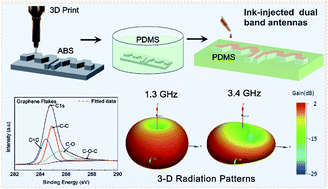Ink-injected dual-band antennas based on graphene flakes, carbon nanotubes and silver nanowires†
Abstract
The transition from the current 4th generation mobile networks (4G) to the next generation, known as 5th generation mobile networks (5G), is expected to occur within the next decade. To provide greater network speed, capacity and better coverage, the wireless broadband technologies need to update traditional antennas for high frequency and millimeter wavelengths. In this study, meander line dipole antennas produced by direct ink-injecting technology have been successfully designed, fabricated and characterized, where the ink-injecting technology may open new routes to the fabrication of wireless antenna applications. An accurate electromagnetic numerical analysis model for the proposed meander line antenna is also developed. The designed dual-band antenna based on graphene flakes and Ag nanowires can operate from 1.2 GHz up to the 1.5 GHz band and from 3.2 GHz up to the 3.8 GHz band with |S11| > 10 dB for wireless communications applications. Different mixtures by mass ratio of aqueous dispersions of CNTs and Ag nanowires (1 : 1, 5 : 1, 10 : 1, 20 : 1) are also prepared to investigate the influence of the network structure on the performance of the meander line antennas.



 Please wait while we load your content...
Please wait while we load your content...